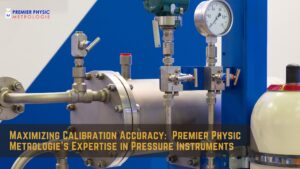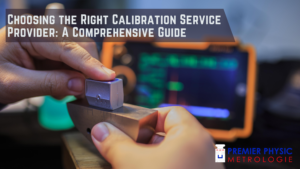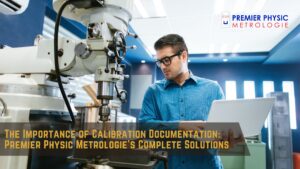Introduction
Overview of Calibration
Calibration is the process of configuring an instrument to provide a result for a sample within an acceptable range. It involves comparing the measurements of a device under test with a reference standard of known accuracy. Calibration ensures that instruments perform accurately and reliably, which is crucial for any scientific, industrial, or commercial process where precision is paramount.
Importance of Accurate Measurements
Accurate measurements are the backbone of quality control in various industries. They ensure that products meet specifications, processes run smoothly, and safety standards are maintained. Inaccurate measurements can lead to product defects, increased costs, safety hazards, and regulatory non-compliance.
Introduction to Premier Physic Metrologie
Premier Physic Metrologie is a leading name in the field of calibration services. With decades of experience, they provide comprehensive calibration solutions to ensure that instruments and devices perform optimally. Their expertise spans across various industries, including manufacturing, healthcare, and environmental monitoring.
Purpose of the Article
This article aims to delve deep into the importance of calibration for accurate measurements. It will explore the different types of calibration, the processes involved, and the significance of maintaining calibration in various industries. Insights from Premier Physic Metrologie will highlight the latest innovations and future trends in calibration.
Understanding Calibration
Definition of Calibration
Calibration is the process of adjusting and verifying the accuracy of an instrument or device by comparing it with a known standard. This ensures that the measurements taken by the instrument are within the specified tolerance levels.
Historical Background
The practice of calibration dates back to ancient civilizations where standard units of measurement were established for trade and construction. Over time, the techniques and standards have evolved, incorporating advancements in technology and science.
Evolution of Calibration Techniques
Calibration techniques have significantly advanced from simple mechanical comparisons to sophisticated electronic and digital methods. The advent of computers and automation has further refined the accuracy and efficiency of calibration processes.
Types of Calibration
Electrical Calibration
Electrical calibration involves testing and adjusting instruments that measure electrical parameters like voltage, current, resistance, and frequency. This is critical in industries such as electronics, telecommunications, and power generation.
Mechanical Calibration
Mechanical calibration pertains to the calibration of physical dimensions and forces. Instruments like micrometers, calipers, and torque wrenches require precise calibration to ensure accurate measurements in manufacturing and engineering applications.
Temperature Calibration
Temperature calibration ensures that thermometers, thermocouples, and temperature sensors provide accurate readings. This is vital in industries like food processing, pharmaceuticals, and environmental monitoring, where precise temperature control is crucial.
Pressure Calibration
Pressure calibration involves the verification of instruments that measure pressure, such as barometers, pressure gauges, and sensors. Accurate pressure measurements are essential in the automotive, aerospace, and industrial sectors.
Flow Calibration
Flow calibration is used to ensure the accuracy of instruments that measure the flow of liquids and gases. This type of calibration is important in water treatment, chemical processing, and HVAC systems.
Mass and Weight Calibration
Mass and weight calibration ensures that scales and balances provide accurate measurements. This is critical in industries such as retail, logistics, and pharmaceuticals, where precise weight measurements are necessary.
Importance of Calibration
Ensuring Accuracy
Calibration ensures that instruments provide accurate measurements, which is crucial for quality control, product consistency, and process efficiency. Accurate measurements help in making informed decisions and maintaining high standards.
Compliance with Standards
Many industries are regulated by strict standards and guidelines. Calibration ensures that instruments meet these regulatory requirements, helping companies avoid legal issues and penalties.
Safety and Reliability
Properly calibrated instruments are essential for ensuring the safety and reliability of processes and products. Inaccurate measurements can lead to safety hazards, product failures, and costly recalls.
Reducing Errors and Wastage
Calibration helps in minimizing measurement errors and reducing material wastage. Accurate measurements lead to efficient use of resources, cost savings, and improved profitability.
Calibration Processes
Pre-Calibration Procedures
Before calibration, it is important to conduct a thorough inspection of the instrument, review its history, and ensure it is clean and functioning properly. This sets the foundation for an accurate calibration process.
Calibration Techniques
Calibration techniques vary depending on the type of instrument and the required level of accuracy. Common methods include comparison with reference standards, use of calibration software, and automated calibration systems.
Post-Calibration Verification
After calibration, it is essential to verify the accuracy of the instrument through tests and measurements. This ensures that the calibration has been successful and the instrument is performing within the specified tolerance levels.
Tools and Instruments for Calibration
Calibrators
Calibrators are devices used to test and adjust the accuracy of instruments. They provide known values that can be compared with the measurements taken by the instrument under test.
Reference Standards
Reference standards are highly accurate devices with known measurement values used as a benchmark for calibration. They are traceable to national or international standards.
Measurement Instruments
Various measurement instruments, such as multimeters, oscilloscopes, and pressure gauges, are used in calibration to measure and verify the accuracy of other devices.
Software Tools
Calibration software tools help automate the calibration process, ensuring consistency and accuracy. They provide data management, analysis, and reporting capabilities, streamlining the calibration workflow.
Calibration in Different Industries
Manufacturing
In manufacturing, calibration ensures that machinery and instruments produce parts and products within specified tolerances. This is essential for maintaining product quality and meeting customer specifications.
Healthcare
In the healthcare industry, calibration of medical devices like blood pressure monitors, thermometers, and diagnostic equipment is critical for patient safety and accurate diagnosis.
Aerospace
Calibration in aerospace ensures the accuracy of instruments used in aircraft and spacecraft. This is crucial for the safety and performance of these vehicles.
Energy
In the energy sector, calibration of instruments used in power generation, transmission, and distribution ensures efficient and reliable energy supply.
Environmental Monitoring
Calibration of instruments used in environmental monitoring, such as air quality sensors and water quality testers, ensures accurate data collection for regulatory compliance and environmental protection.
Challenges in Calibration
Environmental Factors
Environmental conditions, such as temperature, humidity, and vibration, can affect the accuracy of calibration. Controlling these factors is essential for reliable calibration results.
Human Error
Human error during the calibration process can lead to inaccurate results. Proper training, procedures, and automation can help minimize these errors.
Instrument Wear and Tear
Instruments can degrade over time due to wear and tear, affecting their accuracy. Regular calibration and maintenance are necessary to ensure continued precision.
Technological Limitations
Technological limitations of calibration equipment and techniques can pose challenges. Continuous innovation and investment in advanced calibration technologies are necessary to overcome these limitations.
Latest Innovations in Calibration
Automation in Calibration
Automation in calibration reduces human error, increases efficiency, and ensures consistency. Automated calibration systems can perform complex calibrations with high precision.
Digital Calibration Systems
Digital calibration systems use advanced software and digital interfaces to enhance the accuracy and efficiency of the calibration process. They provide real-time data and streamlined workflows.
Real-Time Calibration Monitoring
Real-time calibration monitoring allows continuous tracking of instrument performance. This ensures that any deviations are detected and corrected immediately, maintaining accuracy.
Advanced Materials for Calibration Standards
The development of advanced materials for calibration standards improves their stability and accuracy. These materials provide better resistance to environmental factors and wear.
Future of Calibration
Emerging Trends
Emerging trends in calibration include the use of nanotechnology, advanced sensors, and integrated systems. These trends are driving improvements in accuracy and efficiency.
Role of Artificial Intelligence
Artificial intelligence (AI) is playing an increasing role in calibration. AI algorithms can analyze large datasets, predict calibration needs, and optimize calibration processes.
Integration with IoT
The integration of calibration with the Internet of Things (IoT) allows for seamless data collection and analysis. IoT-enabled devices can communicate and coordinate calibration activities in real-time.
Sustainability and Calibration
Sustainability is becoming a key focus in calibration, with efforts to reduce waste, energy consumption, and environmental impact. Green calibration practices are being adopted across industries.
Case Studies
Successful Calibration in Manufacturing
A leading automotive manufacturer implemented an automated calibration system, resulting in improved product quality and reduced production costs. The system ensured precise calibration of machinery and tools.
Calibration in Medical Devices
A hospital upgraded its calibration procedures for medical devices, ensuring compliance with regulatory standards and enhancing patient safety. This led to more accurate diagnoses and treatments.
Aerospace Calibration Challenges
An aerospace company faced challenges in calibrating instruments for extreme conditions. By adopting advanced calibration techniques and materials, they achieved reliable and accurate measurements for their aircraft.
Environmental Monitoring and Calibration
An environmental agency improved the accuracy of its air quality monitoring systems through rigorous calibration. This ensured compliance with environmental regulations and provided reliable data for public health assessments.
Expert Insights
Quotes from Calibration Specialists
“Calibration is not just a technical requirement; it’s a fundamental aspect of quality and safety in any industry.” – Dr. Jane Smith, Calibration Expert
“Investing in advanced calibration technologies pays off in terms of accuracy, efficiency, and regulatory compliance.” – John Doe, Calibration Engineer
Advice for Maintaining Calibration Accuracy
- Schedule regular calibration checks.
- Use high-quality reference standards.
- Train personnel thoroughly.
- Implement automated calibration systems where possible.
Future Predictions by Industry Leaders
Industry leaders predict that calibration will become increasingly automated and integrated with AI and IoT technologies. This will lead to higher accuracy, efficiency, and real-time monitoring capabilities.
FAQs about Calibration
What is Calibration?
Calibration is the process of adjusting and verifying the accuracy of an instrument or device by comparing it with a known standard.
Why is Calibration Necessary?
Calibration is necessary to ensure that instruments provide accurate and reliable measurements, which is critical for quality control, safety, and regulatory compliance.
How Often Should Calibration be Done?
The frequency of calibration depends on the type of instrument, its usage, and industry standards. Generally, it is recommended to calibrate instruments at least once a year.
What are the Common Methods of Calibration?
Common methods of calibration include comparison with reference standards, use of calibration software, and automated calibration systems.
What are the Consequences of Skipping Calibration?
Skipping calibration can lead to inaccurate measurements, product defects, safety hazards, and regulatory non-compliance, resulting in increased costs and potential legal issues.
Conclusion
Summary of Key Points
Calibration is essential for ensuring the accuracy and reliability of measurements in various industries. It involves adjusting and verifying instruments using known standards to maintain precision and compliance with regulations.
Final Thoughts on Calibration
Accurate measurements are crucial for quality control, safety, and efficiency. Investing in advanced calibration techniques and technologies is vital for maintaining high standards and staying competitive.
For more information on calibration and how it can benefit your industry, consider reaching out to Premier Physic Metrologie. Stay updated with the latest trends and advancements in calibration to ensure your instruments perform at their best.




